Take a tip from Norm Macdonald
What can you learn from Norm Macdonald’s Twitter tribute to Robin Williams?

Here’s how to serialize your story, how to get the word out in 144 (or 288) characters or less — and when to stop typing.
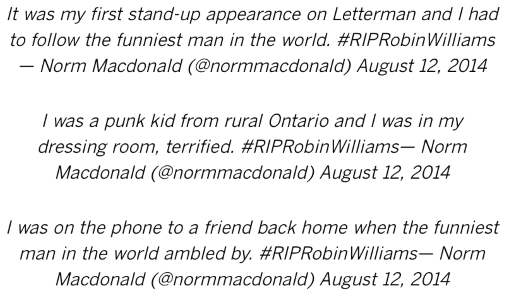
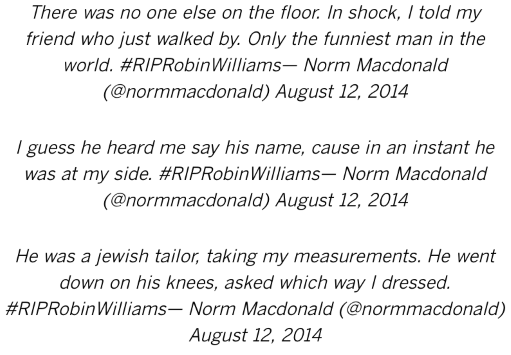
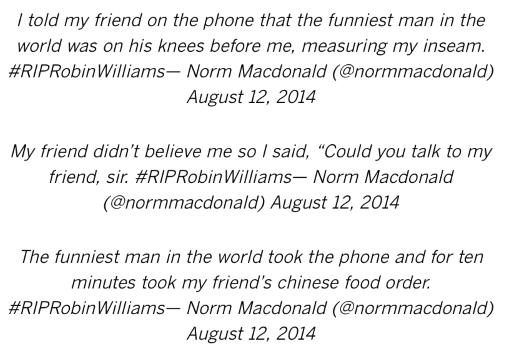
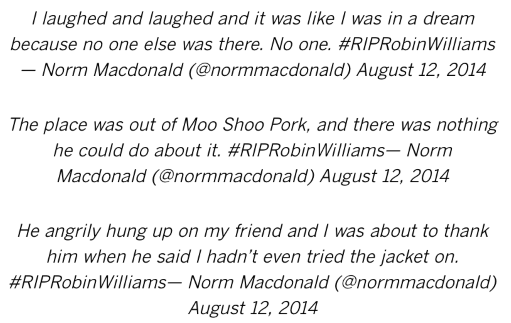
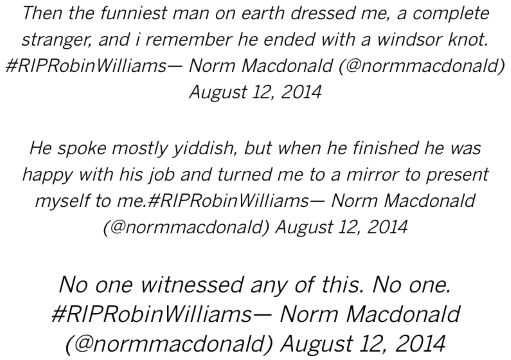
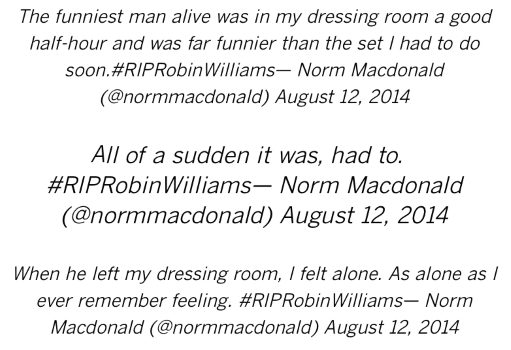

What to learn from this serial
Here are six tips to take from Macdonald’s tribute:
1. Tell a story.
Heck, tell two stories. Why not make it three?
Macdonald’s 19 tweets compose three stories: the Jewish tailor story, the Chinese order-taker story and overarching the “Funniest man in the world walks into a dressing room” story. Robin Williams was his own secondary character.
2. Serialize your story.
Newspapers have been publishing serial narratives since a young reporter named Charles Dickens wrote the first one for London’s Morning Chronicle in 1836.
Serializing your story is a great way to make your tweets go further. But do it right:
- Break it up. Macdonald sees his story as a series of scenes. That makes it easy for him to break it up into tweets.
- Keep it together. You can repeat the main headline, add Part I and Part II or use words like “therefore,” “continued” and “update” to signal that these tweets have something in common. Macdonald uses the hashtag #RIPRobinWilliams to organize individual tweets into a complete story.
- Post in reverse order so readers see the “first” tweet first in your stream. Macdonald tweeted in order, which means followers must read this Twitter tale backward.
3. Start strong.
The most compelling stories have one strong summary sentence close to the beginning, Catherine Burns, artistic director of the Moth, a New York City-based organization dedicated to storytelling, tells Real Simple.
“‘I fell into the pool in my wedding dress,’ say, or ‘A violent stomachache ruined our first date.’”
Macdonald’s lead strikes the same chord: “It was my first stand-up appearance on Letterman, and I had to follow the funniest man in the world.”
Notice that Macdonald saves the background section for after he gets your attention: “I was a punk kid from rural Ontario and I was in my dressing room, terrified.”
4. Keep it short.
All three of Macdonald’s stories together weigh in at less than 350 words, give or take a few hashtags.
5. But don’t compress the life out of it.
Notice that Macdonald didn’t lose details when he tightened his tale into tweets. Regardless of how tight the space, Macdonald keeps our attention with concrete details like:
- He was a Jewish tailor, taking my measurements.
- He went down on his knees, asked which way I dressed.
- The place was out of Moo Shoo Pork …
- … he ended with a Windsor knot.
- He spoke mostly Yiddish …
6. Know when to quit.
Endings are as important as openings. Macdonald finished his story, though, a tweet before he stopped typing.
Notice the many ways that the final tweet does not work with the rest of this piece:
It adds emotion to observation. Tell the story you’ve observed, then let readers have the emotional response. This rule is also known as, “Make the reader cry; don’t tell the reader you cried.”
“Have you ever noticed,” asks a character in Richard Yates’ Young Hearts Crying, “how your sympathy for someone’s story — anyone’s story — tends to evaporate when they get to the part about how long and hard they cried?”
That’s what happened to me when I read Macdonald’s last tweet.
- It’s long. Most of the words in Macdonald’s tweets are one — maybe two — syllables long. Other than Ontario, though, “unacceptable” is the only word in this Twitter tale that’s four syllables long.
- It’s abstract. As William Carlos Williams counseled, “Turn ideas into things.” Macdonald’s ending does the reverse: In a series of concrete words, this is the rare abstract one.
The true ending of this story is “Until now.”
When you finish your story, stop typing.
Resources on serializing your story
Here are more examples and techniques for breaking your narrative into successive — and successful — parts.
Roy Peter Clark’s serials
The editorial guru of The Poynter Institute is a serial master. Among his serial narratives
- “Three Little Words” appeared in the St. Petersburg Times for 29 consecutive days in 1996. It told the story of a woman, Jane Morse, whose husband died of AIDS.
- “Sadie’s Ring” was published in five newspapers in 1996 and 1997. This 11-part series tells Clark’s personal story of growing up Catholic with a Protestant father and a Jewish grandmother.
- “Ain’t Done Yet” appeared as a millennium special in 25 newspapers. This newspaper novel ran for 29 consecutive days.
- “Her Picture in My Wallet” is a two-part piece about a World War II veteran reunited with his first love after years of separation and regret. It’s told in the voice of the main character, 77-year-old Tommy Carden.
Creating the Serial Narrative: A Starter Kit
Clark helps the rest of us write successful serials in (I guess it should go without saying) this six-part piece:
- The Power of the Parts: Why serialize stories?
- A 12-Step Program for Writers: Is this the right story for a serial?
- A Story Form with Benefits: What’s the business case for serials?
- How Could You Ask Such a Thing? Readers ask; Roy answers
- Say the Secret Word: A glossary for serials. And for stories.
More serials
- Black Hawk Down: Yup, the movie and best-seller started life as a 29-part serial in The Philadelphia Inquirer.
- The Terrorist Within: A 17-part serial narrative about one man’s holy war against America, published by The Seattle Times.
More serial success secrets
- The Verdict Is in the 112th Paragraph: Tom French goes behind the scenes to explain how — and why — he crafted his serial narrative about the Valessa Robinson case.
- To Be Continued: A Serial Narrative Primer by Chip Scanlan for the Poynter Institute
Soap operas & sagas
- Telenovelas and Soap in Latin America: It’s just one short step from serials to soap operas
- The Holly Wreath Man: A fictional saga, published in The Seattle Times

Leave a Reply